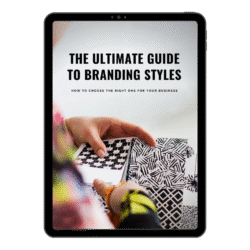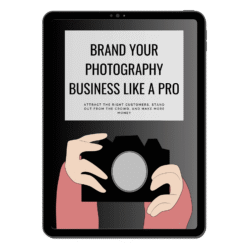Branding ebook: The Ultimate Guide to Branding Styles
Are you struggling to create a strong and effective brand image for your business?

Look no further than The Ultimate Guide to Branding Styles: How to Choose the Right One for Your Business ebook. This comprehensive resource offers practical advice and valuable insights on developing a branding strategy that aligns with your business goals and resonates with your target audience. In this post, we’ll explore the importance of branding and how this branding ebook can help transform your brand image.
What is branding is and why it’s important for businesses
Branding is the process of creating a unique identity and image for a business, product, or service in the minds of customers. It involves designing a logo, choosing colors and typography, developing a messaging strategy, and creating consistent visual and verbal language across all touchpoints.
Branding is important for businesses for several reasons. First and foremost, a strong brand can differentiate a business from its competitors and create a sense of trust and loyalty among customers. It can also help businesses establish an emotional connection with their target audience and communicate their values and personality. A well-executed branding strategy can also lead to increased recognition and visibility, which can lead to higher sales and customer retention.
Branding is an essential part of building a successful and sustainable business.
A brief overview of Branding ebook – The Ultimate Guide to Branding Styles
Are you struggling to create a strong brand image for your business?
The Ultimate Guide to Branding Styles: How to Choose the Right One for Your Business ebook can help you develop a branding strategy that aligns with your goals and target audience. Here are five reasons why you should purchase the ebook today:
- Comprehensive coverage: The ebook covers all aspects of branding strategy, including clarity, colors, messaging, brand elements, and styling.
- Practical advice: The ebook provides practical advice and guidance on how to choose the right branding style, create a messaging strategy, develop a visual identity, and plan a content strategy that aligns with your goals.
- Valuable insights: The ebook offers valuable insights into the four main branding styles and how they can be used to create a cohesive and effective branding strategy.
- Easy to follow: The ebook is easy to follow, with step-by-step guidance on how to create a mood board, choose the right colors, and create a brand board.
- Affordable: The ebook is an affordable resource that can help you develop a strong brand image for your business without breaking the bank.
So why wait?
Definition of branding styles and why they matter
Branding styles refer to the different visual and messaging strategies that businesses can use to create a unique identity and image for their brand.
Each branding style has its distinct characteristics, including color palettes, typography, imagery, and messaging tone.
Branding styles matter for businesses because they can have a significant impact on how customers perceive their brand. By choosing the right branding style, businesses can communicate their values, personality, and positioning in the market. For example, a youthful branding style might be more appropriate for a brand targeting a younger demographic, while an elegant branding style might be more suitable for a high-end luxury brand.
Branding styles can also help businesses differentiate themselves from their competitors and establish a unique identity in the minds of customers.
By consistently using a specific branding style across all touchpoints, businesses can create a recognizable and memorable brand image that sets them apart in the market.
Overview of the 4 branding styles covered in the ebook: Youthful, Elegant, Earthy, Luxury
- Youthful: This branding style is characterized by bright colors, playful typography, and energetic visuals. It’s a great fit for brands targeting younger demographics and those in industries like fashion, entertainment, and technology.
- Elegant: An elegant branding style is all about sophistication and refinement. It typically features classic typography, a pale color palette, and high-quality imagery. This style is ideal for luxury brands, high-end restaurants, and businesses in the beauty industry.
- Earthy: The earthy branding style draws inspiration from nature, with a focus on organic shapes, natural materials, and intensive, earthy shades. It’s a great choice for brands in the wellness, beauty, and sustainable fashion industries.
- Luxury: Luxury branding is all about creating an exclusive and aspirational image for your business. It often features elegant typography, high-quality photography, and a rich and clear color palette. This style is ideal for luxury fashion brands, high-end hotels, and upscale restaurants.
The importance of choosing the right branding style for your business
Choosing the right branding style for your business is crucial because it can significantly impact how your brand is perceived by your target audience.
Your branding style is essentially the visual and messaging language that you use to communicate your brand identity, values, and personality.
If you choose the wrong branding style, it can confuse or turn off potential customers, leading to a lack of engagement, loyalty, and ultimately, sales. For example, if you choose a youthful branding style for a luxury brand, it may not resonate with your target audience, who may perceive your brand as cheap or unprofessional. Similarly, if you choose a minimalist branding style for a fun and playful brand, it may not effectively convey the energy and excitement of your brand.
On the other hand, if you choose the right branding style for your business, it can help you establish a strong emotional connection with your target audience, differentiate yourself from competitors, and increase brand awareness and loyalty. A well-executed branding style can also make your brand more memorable and recognizable, which can lead to increased word-of-mouth marketing and referral business.
This is why choosing the right branding style for your business is a crucial part of developing a successful branding strategy. It can help you effectively communicate your brand identity and values to your target audience, create a memorable and recognizable brand image, and ultimately, drive business growth and success.
Factors to consider when selecting a branding style
When selecting a branding style for your business, there are several important factors to consider.
These include:
- Target audience: Your branding style should appeal to your target audience and be tailored to their preferences and expectations. For example, a youthful branding style may be more appropriate for a brand targeting Gen Z and millennials, while an elegant branding style may be more suitable for an older demographic.
- Industry: Your branding style should also be appropriate for your industry and the type of products or services you offer. For example, an earthy branding style may be a good fit for a brand in the natural beauty industry, while a luxury branding style may be more appropriate for a high-end fashion brand.
- Brand identity: Your branding style should align with your brand identity, values, and personality. For example, if your brand values sustainability and eco-friendliness, an earthy branding style may be a good fit.
- Competitors: It’s also important to consider your competitors and how you can differentiate yourself in the market. Your branding style should be unique and distinguishable from your competitors’ branding styles.
- Long-term goals: Finally, it’s important to consider your long-term goals for your brand. Your branding style should be flexible enough to accommodate future growth and changes in your brand identity and values.
So remember, selecting the right branding style for your business requires careful consideration of these and other factors to ensure that your branding strategy effectively communicates your brand identity and values, resonates with your target audience, and differentiates your brand from competitors.
Breakdown of each of the 4 branding styles, including their strengths, weaknesses, and ideal business types
Youthful branding style:
Strengths: The youthful branding style is energetic, fun, and playful, making it ideal for brands targeting a younger demographic.
It can be used to create a sense of excitement and enthusiasm around a brand and can be particularly effective for brands in the entertainment, fashion, and beauty industries.
Weaknesses: One of the main weaknesses of the youthful branding style is that it may not be appropriate for all types of businesses.
Brands in more serious or professional industries may struggle to convey a sense of credibility and authority with a youthful branding style. Additionally, if not executed properly, the youthful branding style can come across as unprofessional or immature.
Ideal business types: Brands targeting Gen Z and millennials, particularly in the entertainment, fashion, and beauty industries.
Elegant branding style:
Strengths: The elegant branding style is sophisticated, refined, and luxurious, making it ideal for high-end brands targeting an affluent demographic. It can create a sense of exclusivity and status around a brand and can be particularly effective for brands in the fashion, jewelry, and hospitality industries.
Weaknesses: One of the main weaknesses of the elegant branding style is that it can come across as elitist or snobbish if not executed properly. It may also be difficult for some brands to effectively convey their values and personality with an elegant branding style.
Ideal business types: High-end luxury brands targeting affluent consumers, particularly in the fashion, jewelry, and hospitality industries.
Earthy branding style:
Strengths: The earthy branding style is natural, organic, and eco-friendly, making it ideal for brands that value sustainability and environmentalism. It can create a sense of authenticity and transparency around a brand and can be particularly effective for brands in the natural beauty, health, and wellness industries.
Weaknesses: One of the main weaknesses of the earthy branding style is that it may not be suitable for all types of businesses. Brands in more traditional or corporate industries may struggle to effectively communicate their values and personality with an earthy branding style.
Ideal business types: Brands that value sustainability and environmentalism, particularly in the natural beauty, health, and wellness industries.
Luxury branding style:
Strengths: The luxury branding style is opulent, extravagant, and indulgent, making it ideal for high-end brands targeting an affluent demographic. It can create a sense of exclusivity and status around a brand and can be particularly effective for brands in the automotive, fashion, and hospitality industries.
Weaknesses: One of the main weaknesses of the luxury branding style is that it can come across as ostentatious or out-of-touch if not executed properly. It may also be difficult for some brands to differentiate themselves from competitors with a luxury branding style.
Ideal business types: High-end luxury brands targeting affluent consumers, particularly in the automotive, fashion, and hospitality industries.
The key elements of a branding strategy, including logo design, color palette, typography, and messaging
- Logo Design: A logo is the centerpiece of a brand’s visual identity and should be designed to be recognizable, memorable, and reflective of the brand’s personality and values. It should be simple, versatile, and easily identifiable, and should be designed to work effectively across different mediums and sizes.
- Color Palette: A color palette is a set of colors that are used consistently across a brand’s visual identity. It should be carefully chosen to reflect the brand’s personality and values and should create an emotional connection with the target audience. Colors can evoke different emotions and can influence how people perceive a brand, so it’s important to choose colors that align with the brand’s identity.
- Typography: Typography refers to the fonts and typefaces used in a brand’s visual identity. It should be consistent and easy to read across different mediums and should be reflective of the brand’s personality and values. Different typefaces can evoke different emotions, so it’s important to choose fonts that align with the brand’s identity and messaging.
- Messaging: Messaging refers to the tone, voice, and language used in a brand’s communications. It should be consistent and reflective of the brand’s personality and values and should resonate with the target audience. Messaging can include taglines, brand positioning statements, and brand stories, and should be designed to communicate the brand’s unique value proposition.
By focusing on these key elements, a branding strategy can effectively communicate a brand’s identity, values, and personality to its target audience.
These elements should be designed to work together seamlessly and consistently across all touchpoints to create a cohesive and memorable brand experience for customers.
How to use the branding style you’ve chosen to inform your branding strategy
Once you have chosen a branding style that aligns with your business goals and target audience, you can use it to inform your overall branding strategy.
Here are some ways to do so:
- Visual Identity: Your branding style should inform the visual identity of your brand, including your logo design, color palette, typography, and other visual elements. For example, if you have chosen an “earthy” branding style, you might use natural colors, organic shapes, and hand-drawn typography to create a visual identity that reflects your brand’s connection to nature.
- Messaging: Your branding style should also inform your brand’s messaging and tone of voice. For example, if you have chosen a “luxury” branding style, you might use sophisticated and refined language that speaks to your target audience’s desire for exclusivity and quality.
- Content Strategy: Your branding style can also inform your content strategy by guiding the type of content you create and the channels you use to distribute it. For example, if you have chosen a “youthful” branding style, you might create fun and engaging social media content that resonates with your younger target audience.
- Customer Experience: Finally, your branding style should inform the overall customer experience that you create for your target audience. For example, if you have chosen an “elegant” branding style, you might design a user experience that is smooth, polished, and sophisticated to create a sense of luxury and exclusivity.
Keep in mind that your chosen branding style should inform all aspects of your branding strategy to create a consistent and cohesive brand experience that resonates with your target audience.
By using your branding style to guide your decisions, you can ensure that your branding strategy is aligned with your business goals and effectively communicates your brand’s unique value proposition to your customers.
“The Ultimate Guide to Branding Styles” ebook helps you choose the right branding style and develop a cohesive branding strategy
In summary, branding is essential for businesses as it helps to establish a strong and recognizable identity that resonates with their target audience, builds trust and credibility, and sets them apart from their competitors.
A well-executed branding strategy can have a significant impact on a business’s success.
The Ultimate Guide to Branding Styles eBook provides valuable information and guidance on how businesses can choose the right branding style that aligns with their business goals and target audience. It offers a comprehensive overview of the four main branding styles: youthful, elegant, earthy, and luxury, outlining their strengths, weaknesses, and ideal business types. Moreover, the ebook provides insights into the key elements of a branding strategy, such as logo design, color palette, typography, and messaging.
By following the ebook’s recommendations, businesses can develop a cohesive and effective branding strategy that resonates with their target audience and reflects their brand’s unique personality and values. It offers practical tips and advice on how to craft a messaging strategy, develop a visual identity, and plan a content strategy that aligns with their chosen branding style.
Last Updated on 05/03/2025 by Victoria Silber








